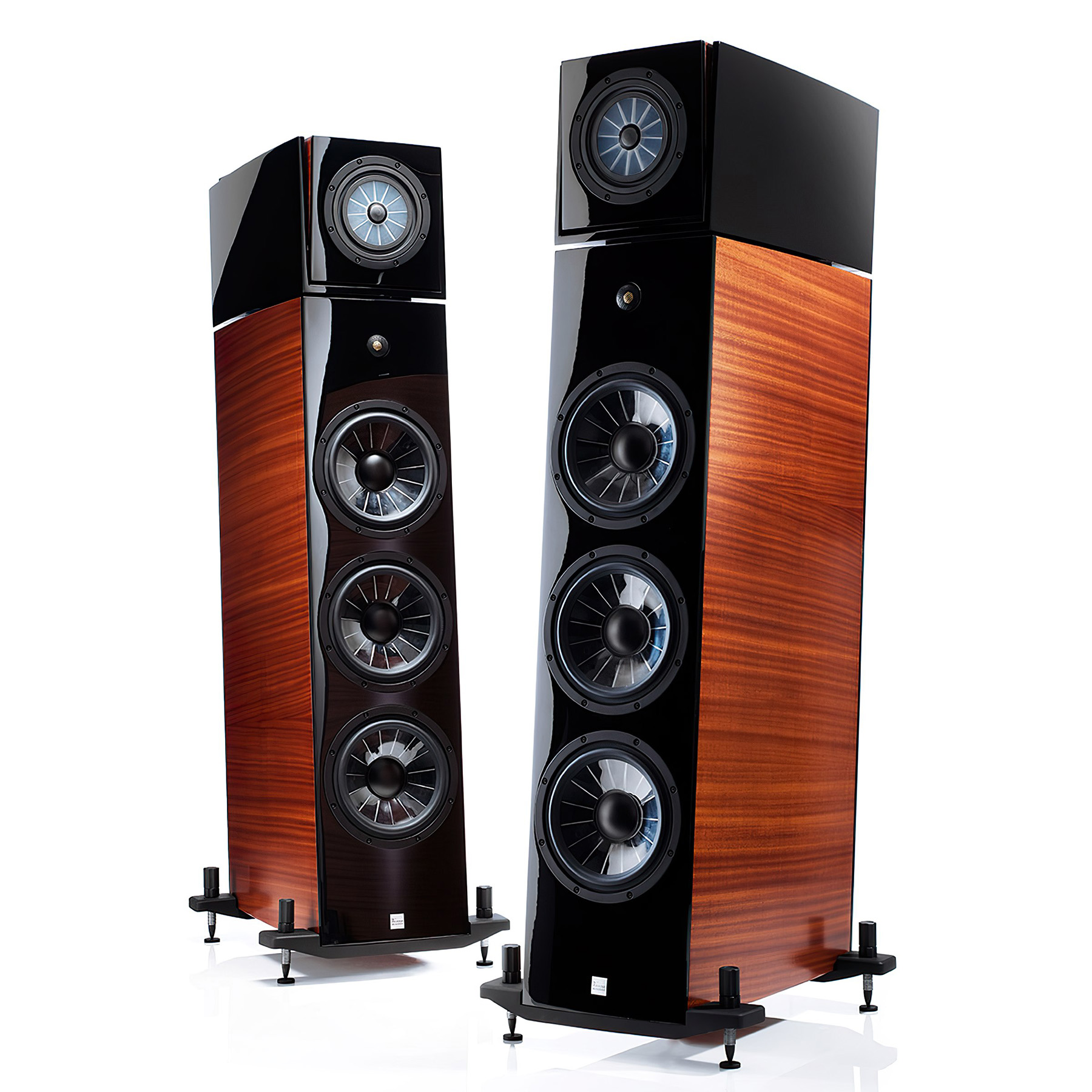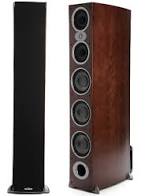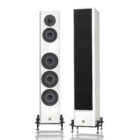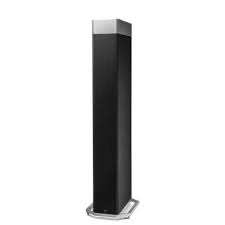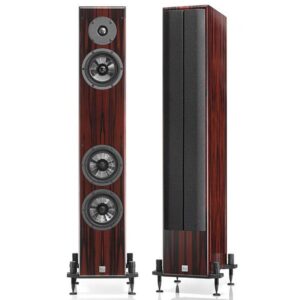Vienna Acoustics The Music Floorstanding Speaker
Description
Passion, skill, leadership, innovation, vision, harmony, teamwork: the words that evoke Klimt and his Art were also always target for Vienna Acoustics and the company’s latest achievement, the first model out of the Klimt Series, “THE MUSIC”.
Revolution
Vienna Acoustics´ “THE MUSIC” introduces a truly revolutionary new flat, concentric 18 cm driver that closely approximates the Platonic ideal for which speaker designers have been striving. It places 7 octaves of music in a single, phase coherent time plane. With a wave launch that mimics a “pebble dropped in a still pond”, this remarkable driver reproduces spatial coherence unfamiliar to anyone, save perhaps the original recording engineer.
The physics of this patented driver are an outgrowth of Vienna´s longstanding use of reinforced cones designed to maximize strength at nodal multiples, while keeping mass to a functional minimum.
Flat cones actually do not provide stiffness, but we turned a disadvantage into an advantage by our patented one-sided-cone-light-weight-framing. Not only this delivers the best weight-stiffness ratio of any construction (the construction coming close in stiffness is sandwich, but it is too heavy as it needs a second layer and a dense honeycomb mesh), it also allows specific and calculated sound and impulse-response tuning by varying the quantity of ribs, their shape, their thickness, radial or concentric orientation, and specified placements on critical spots.
Basis for the cone material is TPX, in a proprietary mix with other materials for the optimum result of stiffness/inner-damping ratio in combination with light-weight-framing on the cone’s rear side. The maximum final stiffness is defined by adding glass fibres to the compound, aligned in the optimum arrangement by according injection moulding tool execution. All cones are developed and produced by Vienna Acoustics in Austria, afterwards manufactured to a complete driver by Eton Germany.
By using finite element analysis, Vienna Acoustics´chief designer Peter Gansterer was able to create a radial-vaned structure (like architecture scientists we place a rib where necessary), cast into the flat cone that produces an enormously stiff, flat surface (thereby eliminating time and frequency specific phase shift across the driver), with a new state of the art silk dome tweeter, using a vented neodymium magnet structure placed in its center.
Years of development made the flat cone possible, for Peter Gansterer the prerequisite of a realization of the optimum reproduction unit, a coax. Having 2 drivers at the same center (point source), results in otherwise inaccessible homogenous sound, but current technology of cone shaped midrange diaphragms disqualifies itself by unacceptable colorations of the tweeter by the cone induced hornloading. In our technology it enjoys a flat surrounding as usual in highend applications. Similarily, the midrange itself is uncomparable in its lack of coloration: Cone-shaped drivers reproduce upper midrange mainly by the inner part, which again suffers from the hornloadings distortion.
At the same time our flat cone is ultra-stiff because of the ribs and the glassfibers, but exhibiting smooth musical sound due to the soft inner damping of the TPX material. The resulting piston like behaviour extends the frequency span, resulting in a range from 100 Hz to 20.000 Hz from the coax alone, defining it as the heart of the speaker, thereby being also the heart of music reproduction. We are that enthusiastic about this music center that we gave it its own cabinet.
Above and Below
While the top-unit handles mid and upper bass in its own enclosure, below this primary driver we built a separate large enclosure, featuring 3 proprietary bass drivers, each with our on proprietary 25 cm ultra rigid NAWI cones die cast by Spidercone-framing (finally assembled also by Eton Germany), handling the frequencies from 18 Hz to 100 Hz.
The 3 units are working in parallel, while the upper bass operates in its own chamber.
Finally, a remarkable Supertweeter, manufactured by the Danish high-end specialist ScanSpeak, tops the lower enclosure, extending response from 20.000 Hz upwards to 100.000 Hz.
During development we revealed that piezo technology, which is used in the super-tweeter, has superior advantages above 20.000 Hz (optimum dispersion, acting like balloon inflating).
Form follows function
The total decoupling from the bass chambers allows the coax music center, in its dedicated housing, to reach the absolute optimum in clarity and naturalness in sound.
The cabinetry is clearly evolved to make the most of this technology; the separatetop-unit enclosure is decoupled from the bass enclosure by a high-tec, drawn aluminium swiveljoint, which allows optimum room tuning by enable not only adjustment for rake, but also for toe-in.
This allows you to create a sweet zone rather than a narrow sweet spot. By adjusting the dedicated coax point source cabinet and directing it like swivelling a flashlight you are able to easily create the sweet zone wherever wanted. Furthermore this allows for optimizing the sound to any room condition as many rooms will strongly benefit from the reduction of the disturbing early reflections which cannot properly be separated from the direct signal by the human ear.
As always, the speakers´veneer and finish quality is to the highest of standards. “THE MUSIC” is available in true Piano Black version and Sapele veneer finish.
Specifications
System type
- 3-way system, employing integrated subwoofers
Frequency response
- 22 – 100.000 Hz
Bass drivers
- 3 x 9″ Vienna Acoustics Spidercones, manufactured by Eton Germany
Midrange Coax driver
- 1 x 7″ Vienna Acoustics Flat-Spider, 1 x 1″ , handcoated vented neodym-magnet powered silk dome, manufactured by Eton Germany
Supertweeter
- 0,5″ ScanSpeak
Sensitivity
- 91 dB
Impedance
- 4 ohms
Recommended power
- amplifiers from 50 to 500 watts
Weight per speaker
- 180 Ibs. / 82 kg
Dimensions (WxHxD)
- 10.75 x 50.98 x 24.80 inches
- 273 x 1295 x 630 mm
Finishes
- Sapele, Piano Black
Why Would We Name a Speaker Line after a Painter?
It seemed only natural to name the absolute Reference Vienna Acoustics has ever created in homage to one of the most thrilling artists the city has ever unleashed – a man whose immense achievements in visual art were profoundly inspired by music.
Born just south of the capital in 1862, as a teenager Gustav Klimt studied architectural painting in Vienna before launching his early career as a painter of murals and ceilings. Before Klimt reached his thirtieth year, he had earned recognition from Austria’s emperor and a recommendation to join the faculty of Vienna’s prestigious Academy of Fine Arts. But such a conventional career was not to be for this passionate innovator.
“To the age its art, to art its freedom.”
Gustav Klimt started with the creation of the Beethoven Frieze for the Viennese Secession in 1897. The Secession was no dogmatic federation espousing artistic “rights” and “wrongs”; rather, this was a group of forward thinkers – with Klimt on top – exploring new departures in creation, urging artists of every persuasion – architecture, painting, music – to come together for the sake of progression. Just as important, the Secessionists were determined to bring that progression to the people, via publications and annual exhibitions.
Standing for the unconventional, for freedom from constraints of any kind, Klimt created a worldwide symbol for Jugendstil.
The Beethoven Frieze ranks among the major works of the Viennese Jugendstil and can only be comprehended in the context of this age and as a product of it – an age shaped by tendencies toward new departures in art, by an interest in international connections and by the attempt to bring the various arts together.
The Frieze belongs to the most significantcreations of Gustav Klimt, such as “The Kiss”, and the devoted music lover´s – and avowed Beethoven admirer´s – masterpiece “The Music”.
Art would never be experienced in quite the same way again
